Radiocarbon questions?
- Staff scientist: Chris Ebert
- Faculty: Ted Schuur
- Faculty: Darrell Kaufman
Stable isotope questions?
- Staff scientist: Jamie Brown
- Faculty: George Koch
People and projects
The ACE Isotope Laboratory supports a wide range of radiocarbon and stable isotope research. Within the broad research areas of ecosystems and climate, the ACE Isotope Laboratory has a particular focus on using radiocarbon to understand the interplay between arctic ecosystems and climate. Faculty members and research are featured in these science highlights. Please reach out to individual faculty members with opportunities for new collaborations and research directions.
Dating lake sediments: Kaufman and McKay Accordion Closed
How can we maximize 14C chronological information from lake sediments?
The ACE lab is developing approaches to optimizing the dual graphite and gas-source capabilities of the MICADAS to cost-effectively maximize the geochronological information from lake sediment macrofossils.
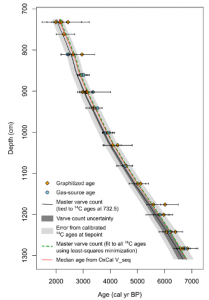
Comparison between graphite and gas-source 14C ages of vegetation macrofossils from lake sediment (Lake Żabińskie, Poland) also dated by annual-layer (varve) counts. Ultrasmall samples were used for gas-source ages. Almost all graphite and gas ages overlap within analytical errors. Where the two differ, graphite-based ages tend to be slightly older, perhaps reflecting a higher proportion of woody material in these larger samples; wood tends to be stored on the landscape before washing into the lake. The data show that using the gas source to increase the sample density across a Holocene sedimentary sequence resulted in a superior age model, despite the lower precision of the gas-source ages. Data was generated on MICADAS at LARA, University of Bern.
Darrell Kaufman is interested in the geochronological applications of radiocarbon. He applies 14C to dating geologic archives of paleoclimate information and to quantifying the time-averaging of carbonate subfossils.
Fire and threshold change: Mack and Walker Accordion Closed
How does the intensification of wildfires impact the long-term carbon (C) storage of boreal and Arctic ecosystems?
One of the most rapid pathways through which climate warming could alter the structure and function of high northern latitude ecosystems is through intensification of wildfire disturbance. The majority of C sequestered in these ecosystems resides in thick soil organic layers (SOL) that can be hundreds to thousands of years old, a C legacy of past fire cycles. The combustion of this ‘legacy C’ could rapidly shift ecosystems across a C cycling threshold, from net accumulation of C from the atmosphere over multiple fire cycles to net loss. Thus, the vulnerability of this C pool to combustion during more intense wildfires could ultimately determine the C balance of boreal ecosystems and their net feedback to climate warming.
Our research investigates how increasing wildfires impact the long-term carbon (C) storage of boreal and Arctic ecosystems. We can use organic soil radiocarbon values to examine historic cycles of SOL combustion and accumulation because organic soil accumulates vertically through time and combustion propagates downward during fire. Stand age at the time of fire determined by dendrochronology can be used in combination with the SOL radiocarbon record to identify both the presence and combustion of legacy C. We define any C older than the stand age at the time of fire as legacy C (Figure 1; Walker et al. 2019, Nature). We found that increased wildfire frequency combusts legacy C and can shift northern ecosystems from a carbon sink to a carbon source to the atmosphere (Figure 2; Walker et al. 2019, Nature).
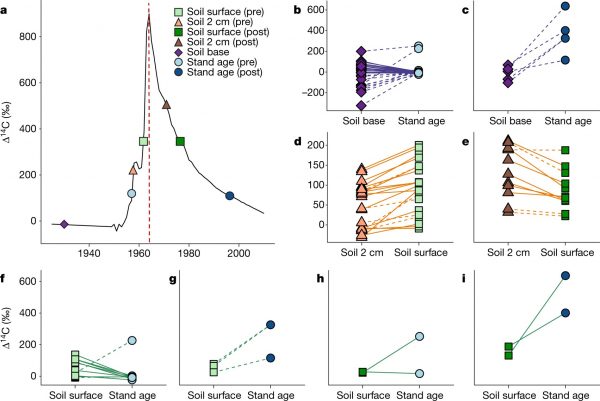
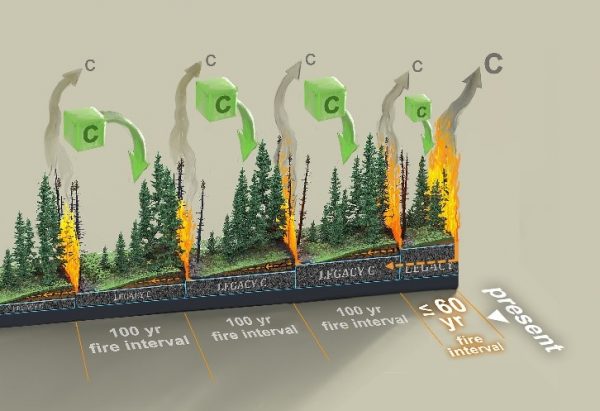
Xanthe Walker is an Assistant Professor at Northern Arizona University’s Center for Ecosystem Science and Society (ECOSS). She is an ecosystem ecologist interested in understanding the impacts of environmental change and disturbance on the structure and function of northern terrestrial ecosystems. She has experience in disturbance ecology, dendrochronology, statistics, and the application of stable and radioactive carbon isotopes.
Website: https://ac.nau.edu/xwalkerlab
Michelle Mack is a Regent’s professor at NAU’s Center for Ecosystem Science and Society (ECOSS) and a recognized leader in plant and ecosystem ecology. Her research focuses on how global climate change is affecting plant health and development. Dr. Mack’s lens is global. Her research includes understanding fire regimens in the boreal forests and the Arctic tundra of North America, analyzing thawing permafrost soils in Siberia, working with huge trees in tropical wet forests of Costa Rica and Panama, and studying savanna ecosystems in South Africa.
Website: https://macklab.nau.edu/
Old carbon metabolism: Schuur Accordion Closed
How much old carbon is being released as greenhouse gas (CO2 and CH4) as the Arctic warms?
Rapid Arctic environmental change affects the entire Earth system as thawing permafrost ecosystems release greenhouse gases to the atmosphere. Understanding how much permafrost carbon will be released, over what time frame, and what the relative emissions of carbon dioxide and methane will be is key for understanding the impact on global climate. Sustained transfers of carbon to the atmosphere that could cause a significant accelerating feedback to climate change must come from old carbon, which has not been part of the active carbon cycle for centuries to millennia and forms the bulk of the permafrost carbon pool. We have begun to apply radiocarbon to field measurements of carbon fluxes to detect the release of old carbon. Because permafrost carbon has been accumulating in these ecosystems over thousands of years, there is a large difference in radiocarbon of organic carbon deep in the soil/permafrost compared to contemporary carbon near the soil surface. Time series of soil and ecosystem respiration radiocarbon from Alaska provides long-term insight into changing permafrost carbon dynamics in a warmer world (See Figure). Nine percent of ecosystem respiration and 23% of soil respiration observations had radiocarbon values more than 50‰ lower than the atmospheric value. The overall trend of ecosystem and soil respiration radiocarbon values through time decreased more than atmospheric radiocarbon values did, indicating that old carbon degradation was enhanced.
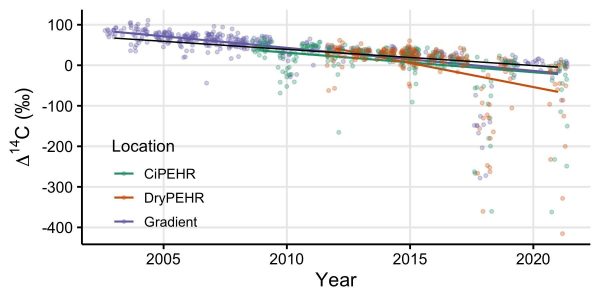
Visit the Schuur Lab Page for more information and photos!
Plant carbon allocation and soil carbon inputs: Carbone and Richardson Accordion Closed
How is carbon allocated in plants?
We use 14C to study the fate of C in plants and soils to better understand the role of terrestrial ecosystems in Earth’s climate system. A research theme we specialize in is using different 14C approaches to study plant C allocation.
We have developed and applied low-level 14C tracers to follow the fate of newly assimilated C in different ecosystems to understand how C is allocated to plant metabolism (Carbone et al. 2007; Carbone & Trumbore 2007). We also apply natural abundance and bomb 14C (Carbone et al. 2023) approaches to understand the availability, distribution, and ecological role of stored nonstructural C (sugars, starch, and lipids) pools in trees (Richardson et al. 2012; Carbone et al. 2013; Richardson et al. 2015).
For example, a recent project looked at the average age (modeled 14C measurement) of stored C allocated to resprouting in giant Coast Redwoods (Sequoia sempervirens) following a catastrophic fire which allowed these iconic trees to survive 100% canopy loss. Check out the video!
Mariah Carbone is interested in studying the modern C cycle with 14C. She applies measurements of 14C on plants, soils, and air to understand how C moves through terrestrial ecosystems and back to the atmosphere.
Andrew Richardson is interested in studying C allocation and metabolism in long-lived woody plants with 14C. He uses measurements and models to draw inferences about stored reserves and their use to support respiration and the growth of woody and non-woody tissues.
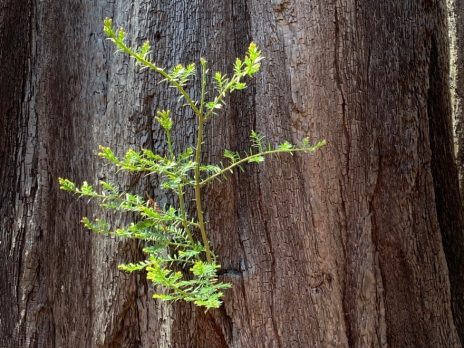
Tracking plant and microbial metabolic water using 18O2: Koch and Schwartz Accordion Closed
What is the fate of metabolic water after cellular respiration?
Organismal water is not only acquired externally but also formed inside cells during aerobic respiration, as oxygen (O2) is reduced at the terminus of the electron transport chain and “metabolic water” is produced. The vital role of metabolic water has long been recognized, the classic example being desert rodents for which metabolism can supply nearly all required water (Schmidt-Nielsen 1965).
Understanding the fate of metabolic water, its movement within organisms, its exchange between organisms and their environments, and the water balance of cells and organisms can be improved through isotopic analyses of water or biomolecules. To this end, we developed a new method for labeling cellular water of organisms with 18O by provision of 18O2 and its conversion to H218O. We successfully demonstrated 18O2 labeling, via metabolic water, for E. coli cells in solution culture, for soil microbial communities, and for respiring tissues of plants.
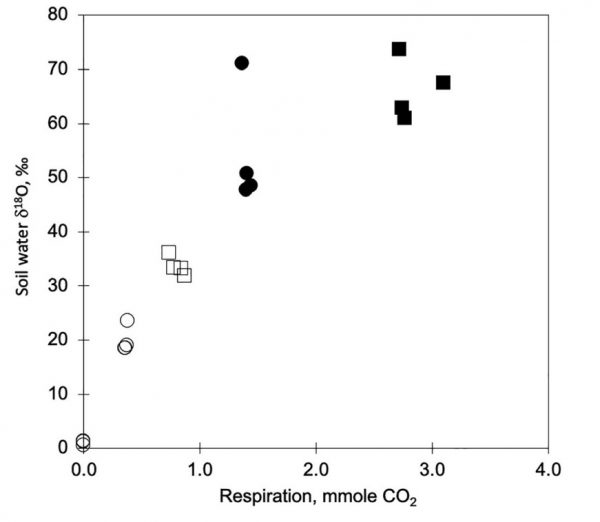
Any organism with aerobic respiration is amenable to labeling with 18O2, and this method enables a new approach to questions regarding plant and microbial physiology. In plants, 18O introduced as metabolic water could be tracked as it moves between living cells and exchanges with apoplastic water, potentially revealing new insights to hydraulic connectivity among pools and a test of longheld models. In microbial systems, this method provides a basis for improved estimates of the contribution of metabolic water to microbial water balance, something previously examined using natural abundance of H and O isotopes.
George Koch’s research focuses on understanding the biophysical and ecological interactions of plants with their environments, including features affected by human-driven global change. He has worked in a variety of terrestrial ecosystems ranging from tropical and temperate rainforests to deserts. Much of his research explores the interaction of water relations and carbon metabolism, a relationship central to the challenge of plant and microbial life on land.
Egbert Schwartz’s research focuses on the interaction between microbial populations and their environment. He is particularly interested in the relationships between microbial growth or activity and soil processes.